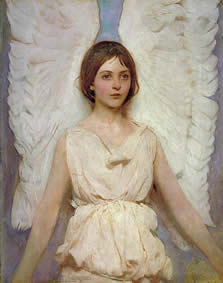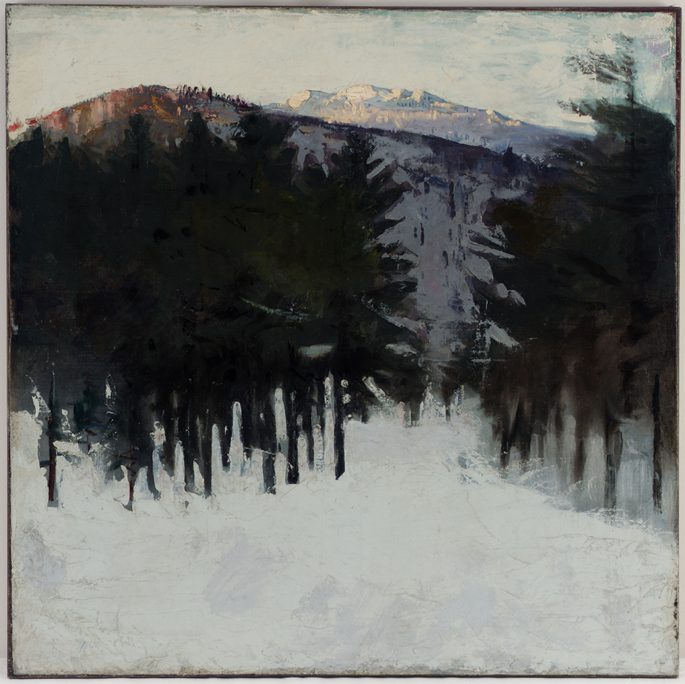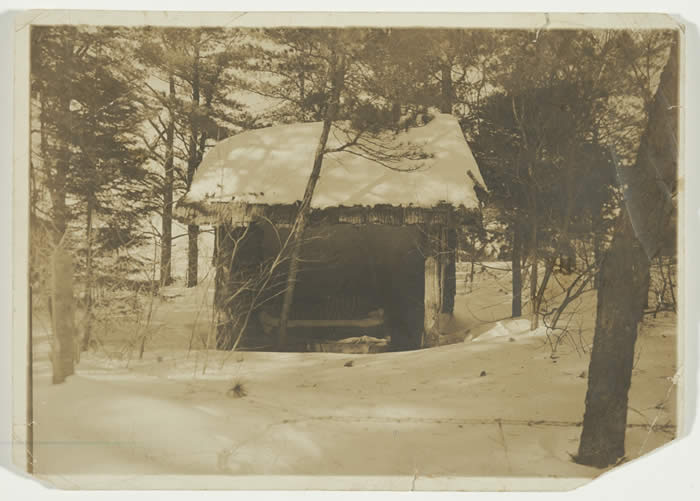Elizabeth Lee
Carlisle, Pennsylvania, United States
A longer version of this article was published in American Art, Volume 18, Number 3. © 2004 by The University of Chicago Press.

In the late 1880s, the painter Abbott Handerson Thayer (1849-1921) and his family began summering in rural Dublin, New Hampshire, near his childhood home in Keene, where the artist started painting the classically-inspired angels and Madonnas for which he is best known.1 This essay examines some of these works using a novel interpretation, by linking the subject matter to the disease and death of Thayer’s first wife, Kate. Over the years scholars have regarded Kate’s death cursorily, as the result of melancholia and a “pulmonary complication,” but recent recognition that she died from tuberculosis offers a new avenue of understanding. Diagnosed with severe melancholia in 1888 following the death of her father and her daughter’s sickness from scarlet fever, Kate was initially hospitalized, then admitted to a Massachusetts asylum. Her already fragile condition was soon complicated by tuberculosis, a discovery that prompted doctors to move her to a healthier environment. Within a month of her arrival at a Baldwinsville, Massachusetts, sanatorium, however, Kate Thayer’s condition rapidly declined. She died on May 3, 1891.2
Tuberculosis was considered a disease of refinement in the early nineteenth century, the era of John Keats and Frédéric Chopin. But by 1882, in the wake of Robert Koch’s discovery of the tubercle bacillus, a fear of contagion and germs had replaced the discourse of romantic genius. No longer believed to be passed through family bloodlines, tuberculosis was reconfigured as a disease of the masses—a by-product of modernization or, as recent historians have called it, society’s “price” for industrialization. Since the nature of modern life in the city made contact with the tubercle bacillus impossible to avoid, medical advice instead emphasized strengthening individual immunity. The best way to increase resistance was to limit one’s exposure to the city, given its density of contagion. While doctors debated what kind of setting—wooded, high altitude, desert, or seaside—proved the most beneficial, all agreed that the goal was to find an environment “uncontaminated by civilization.”3

By the end of the nineteenth century, such therapeutic settings had been institutionalized through the sanatorium movement. In the words of the renowned physician Edward Livingston Trudeau, the sanatorium was designed to “improve the patient’s nutrition and increase his resistance to the disease, by placing him under the most favorable environment obtainable.” As Trudeau went on to explain, the “main elements of such an environment are an invigorating climate, an open-air life, rest, coupled with the careful regulation of the daily habits and an abundant supply of nutritious food.” Built far from polluted cities, sanatorium facilities featured structures like the lean-to pictured here at Loomis Sanatorium in the Adirondacks, which provided round-the-clock access to cleansing, therapeutic air. Combined with other aspects of the experience, as described by Trudeau, it was hoped that the sanatorium stay would sufficiently fortify a patient’s immunities to allow for a safe and healthy reintegration into modern metropolitan life.4 In theory, the principles of “climate therapy,” as it was often called, were beneficial even in the absence of manifest symptoms. Doctors such as Edward Otis, author of The Great White Plague: Tuberculosis, hoped that patients could return home following a sanatorium stay as “apostles of the fresh air life and wholesome living in the communities in which they reside,” instructing those around them in its tenets. For the family and friends of a recovering patient, such guidance was particularly important, since prolonged intimate contact with the disease increased a person’s risk of contracting it.5

Although Kate Thayer’s sanatorium stay allowed for limited family contact, her husband and children nevertheless adopted what appears to have been their own version of a therapeutic regime. According to Thayer’s father, Abbott and his three young children retreated to Dublin on May 15, 1891, less than two weeks after Kate’s death. There, the artist intended “to paint no more portraits this summer, and to take no pupils—but to rest in landscapes,” painting only on rainy days. Throughout his career, Thayer had struggled with his health. In a letter to patron Charles Freer, he acknowledged as much, admitting that his life had “always been different from that of most of the other men. St. Gaudens and Dewing and Tryon for instance know no particular limit to their bodily strength. . . . Whereas I have always been too tired to work over four hours a day and my life has been one steady fight to be fresh enough for continued labor.” In addition to his health concerns, Thayer, who had already lost two sons as infants a decade earlier, was now charged with the care of his three remaining children—Mary, Gerald, and Gladys. In 1890, during Kate’s illness, Thayer’s father wrote in his diary, “Abbott’s children have been well and hearty these two years—thanks to his judicious management and their free outdoor life.” After Kate’s death, Dublin continued to appeal to the artist as a setting well suited to the continued “management” of his family’s health.6
Indeed, visitors to the Thayer homestead in Dublin often remarked on the family’s unusual routine. The painter Rockwell Kent, who worked as a copyist for Thayer, once described the family as a bunch of “nature worshippers.”7 More specifically, according to Barry Faulkner, the artist’s nephew and student, Thayer “shaped his life and the life of his family on Emerson, Audubon and Monadnock.” If nature served as the family’s religion, nearby Mount Monadnock functioned as its shrine. In Faulkner’s words, the Thayers viewed the mountain as “their totem, their fetish, the object of their adoration. They surrendered themselves to the sorcery of its primitive being.” On a typical day, Faulkner recalls, Thayer spent his morning painting, then “climbed the mountain” or took long trail walks with his family. With Gerald especially, he “prowled [Monadnock’s] peaks and precipices, its naked spine, and knew well the mysteries of the mountain brook and its groves of spruce and hemlock.”8 These vigorous explorations encouraged the kind of deep breathing then believed to free toxins from contaminated lungs. According to nineteenth-century health writer Ella Adelia Fletcher, “breath is life, and . . . the more air you breathe in the highest state of purity, the deeper your hold upon life will be and the more radiant your health.” Mountain air was widely considered the best type of air, since a higher elevation all but guaranteed its purity. Many also felt that high-altitude air was particularly effective for tubercular patients. Physician Alfred Loomis attributed his recovery from the disease to the air of the Adirondacks, citing its “specially vitalized and purified atmosphere, free from germs and impurities of any kind, and laden with the resinous exhalations of myriads of evergreens.”9

In keeping with the sanatorium’s fresh-air routine, the Thayers also slept outdoors year-round. According to Faulkner, they read aloud around a fire inside the house at night before bundling up and heading out to their individualized lean-tos, where they were then lulled to sleep by a classical violinist hired by the artist. Among the many structures designed to increase exposure to fresh air during sleep, the three-sided lean-to was deemed a particularly good choice: as one sanatorium physician attested, it “met the requirements for open-air cure more completely and satisfactorily than most others.” Thayer further enhanced its benefits by inventing a breath catcher, a device worn around the nose and mouth, which was intended to prevent the body’s noxious exhalations from freezing onto bedding at night. (He also wore year round a special kind of wool underwear marketed for its protective qualities against disease.) Guests were apparently spared from taking part in this nighttime outdoor ritual. But owing to Thayer’s belief in “all-out exposure to fresh air,” windows in the family home were kept open throughout the year, “except during blizzards and thunderstorms,” Faulkner said, making the cottage frigid in winter.10
In addition to being raised in this open-air setting, Thayer’s children were privately tutored at home on account of their father’s “morbid fear of germs,” Faulkner recalled in his memoir. Keeping his children within his immediate environment served the artist’s emotional and psychological needs as well. Scholar Ross Anderson writes, Thayer relied on his family for “his sense of self-worth”; he “required the unconditional adulation that only members of his own household could provide.” Given the role of his children following Kate’s death, it is perhaps not surprising that they inspired Thayer’s earliest ideal figures. Angel (see above), for instance, represents Mary, the artist’s first daughter and eldest child. Since the timing of the painting roughly coincides with the onset of Kate’s illness, Mary as angel symbolically marks the absence of the woman Thayer “utterly worshipped” and considered “more God-like than anybody else.” The painting may also reference the “angel of death,” a phrase commonly used in the nineteenth century to describe tuberculosis. Mary’s pale, chalky skin, emphasized by the whiteness of her wings and robe, conveys a fragile appearance resembling the effects of consumption when considered alongside her delicate stature and disembodied gaze. Mary/Kate thus binds the contradictory tensions in Thayer’s art, vacillating between healthy daughter and sickly mother in a liminal space that collapses the promise of wholesome youth with the horror of bodily disintegration.11


A few years later all three children appear in Virgin Enthroned, which was completed in 1891, the year of Kate’s death. Using a format adopted from Italian Renaissance art, Thayer portrayed Mary as the seated central figure, assuming the role of her Christian namesake while at the same time stepping in as a substitute for her mother. Thayer had previously pictured his wife as a Madonna in Mother and Child, in which she holds Gerald, the couple’s only surviving son, in a position traditionally assumed by the Christ Child. In Virgin Enthroned, Gerald and Gladys accompany Mary in a manner reminiscent of Renaissance Madonna groupings, such as Leonardo da Vinci’s Virgin of the Rocks, in which Christ and St. John the Baptist appear with the Virgin Mary. In Virgin Enthroned, Thayer’s children provide their father with his own sacred trinity, while serving as reminders of Kate, the continued silent reference in all these works.12
In A Virgin of 1892–93, Thayer repeated his earlier format, albeit transferred to an outdoor setting and with all three figures standing. The clouds, which emerge from Mary’s shoulders as wings, allude to Thayer’s earlier depiction of her in Angel and thus again to her role as a stand-in for Kate. Given the way in which Kate’s illness focused her family’s attention on nature and health, it seems significant, too, that Gerald, Mary, and Gladys, shown barefoot and windswept, are depicted on a vigorous walk. The representation of nature, as seen in the rough, haphazard patches of grass, flowers, and foliage on the ground, may illustrate the sense of primordial nature Thayer admired in Dublin and Monadnock. Immersed in this therapeutic environment while perhaps on one of their daily mountain walks, Thayer’s children embody the life their father embraced and, like their mother, are transformed into sacred figures.
Notes
- The Thayer family first summered in Dublin in 1888, returning in subsequent years before making it their permanent, year-round home in 1901.
- For earlier treatments of Kate’s death, see Nelson White, Abbott H. Thayer: Painter and Naturalist (Hartford: Connecticut Printers, 1951), 57, and Ross Anderson, Abbott Handerson Thayer (Syracuse, N.Y.: Everson Museum, 1982), 20. Richard Murray explicitly acknowledged that she died from tuberculosis, the effects of which were made difficult by her profound melancholia. My analysis here builds on Murray’s finding that Thayer painted his children during Kate’s illness and following her death as a means of consoling his grief. See Murray, “Abbott Thayer’s Stevenson Memorial,” AmericanArt 13 no. 2 (Summer 1999): 3–22.
- On the history of tuberculosis, see Katherine Ott, Fevered Lives: Tuberculosisin American Culture Since 1870 (Cambridge, Mass.: Harvard Univ. Press, 1996); Sheila M. Rothman, Living in theShadow of Death: Tuberculosis and theSocial Experience of Illness in AmericanHistory (Baltimore: Johns Hopkins Univ. Press, 1994); and Rene Dubos and Jean Dubos, The White Plague: Tuberculosis,Man and Society (Boston: Little, Brown and Co., 1952).
- The quote by Trudeau is from Sheila M. Rothman, Living in the Shadow ofDeath, 203.
- Edward Otis, The Great White Plague: Tuberculosis (New York: Thomas Y. Crowell and Co., 1909), 113.
- Dr. Thayer’s Family Record, Abbott Handerson Thayer and Thayer Family Papers, Archives of American Art, reel 48, frames 105 and 91; Abbott Thayer to Charles Freer, May 20, 1893, Thomas Brumbaugh Papers. Fatigue and nervous exhaustion, two ailments Thayer complained of, were common responses to industrial life, as discussed in George Beard, AmericanNervousness: Its Causes and Consequences (New York: G. P. Putnam’s Sons, 1881).
- Rockwell Kent, It’s Me, O Lord: The Autobiography of Rockwell Kent (New York: Dodd, Mead, 1955), 102.
- The quotations are from Barry Faulkner, Barry Faulkner: Sketches from an Artist’sLife (Dublin, N.H.: William L. Bauhan, 1973), 23–24, 28.
- Ella Adelia Fletcher, The Woman Beautiful. A Practical Treatise on the Development and Preservation of Woman’s Health and Beauty (New York: Brentano’s, 1901), 109. The Loomis quote is from Rothman, Living in the Shadow of Death, 159.
- On the lean-tos, see John Bessner Huber, Consumption: Its Relation toMan and His Civilization (Philadelphia: J. B. Lippincott Co., 1906), 222. On the breath catcher, see White, Abbott H.Thayer, 104. Faulkner writes in BarryFaulkner: Sketches from an Artist’s Life, 20, that Thayer maintained these conditions out of the fear that his children “were subject to tuberculosis.” Thayer wore Jaeger underwear year-round (Faulkner, 19). Physician Gustav Jaeger was famous in the Victorian era for his “100% pure, undyed wool underwear.” He claimed that it “prevented the retention of ‘noxious exhalations’ of the body, retained the salutary emanations of the body which induce a sense of vigor and sound health and ensured warmth and ventilation.” Jaeger sold his underwear based on the belief that wool protected against diseases such as cholera, typhus, dysentery, and tuberculosis. See Gary M. Griffin, The History of Men’s Underwear (Los Angeles: Added Dimensions Publishing, 1991), 50.
- Faulkner, Barry Faulkner, 24. Anderson, Abbott Handerson Thayer, 70. Rene and Jean Dubos have discussed how the physical effects of tuberculosis influenced aesthetics in nineteenth-century art; see The White Plague, 56–57. See also Sharon Hirsh, “Codes of Consumption: Tuberculosis and Body Image at the Fin-de-Siècle,” in In Sickness and in Health: Disease as Metaphor in Art and Popular Wisdom, ed. Laurinda S. Dixon (Newark: Univ. of Delaware Press, 2004).
- According to Richard Murray, Thayer’s Virgin Enthroned was interpreted by a critic of the day as a painting of the Virgin Mary with the Christ Child and St. John the Baptist; see Murray, “Abbott Thayer’s Stevenson Memorial,”AmericanArt 13 no. 2 (Summer 1999): 3–22.
ELIZABETH LEE, PhD, teaches modern and contemporary art at Dickinson College. She recently received research fellowships from the Smithsonian Institution, the Huntington Library, the Wolfsonian, and the College of Physicians of Philadelphia to work on her book, Therapeutic Culture: Health and Illness in Turn-of-the-Century American Art, which examines how issues of health and illness inform artistic practice among Gilded-Age artists and collectors.
Highlighted in Frontispiece Fall 2010 – Volume 2, Issue 3

Leave a Reply